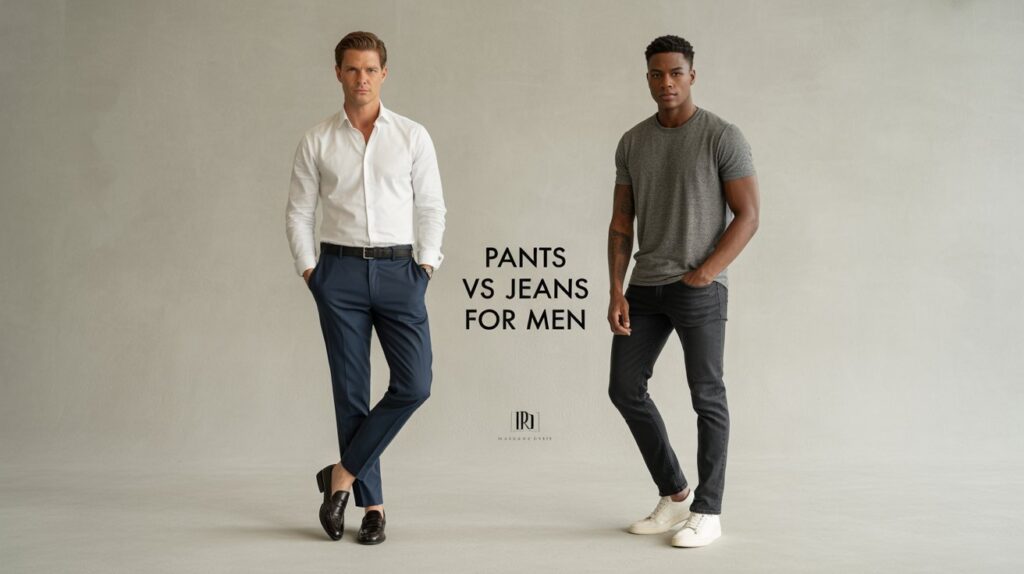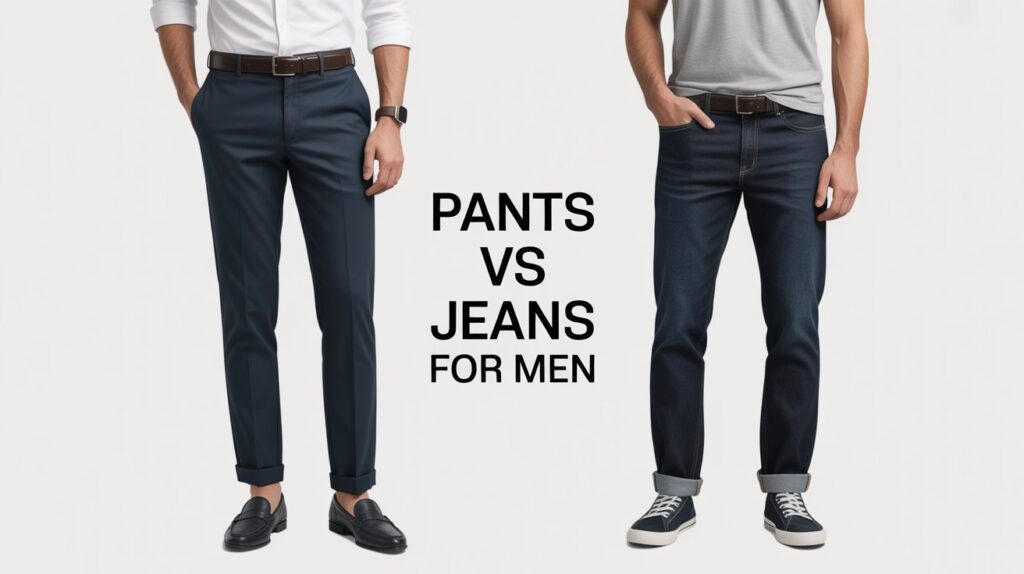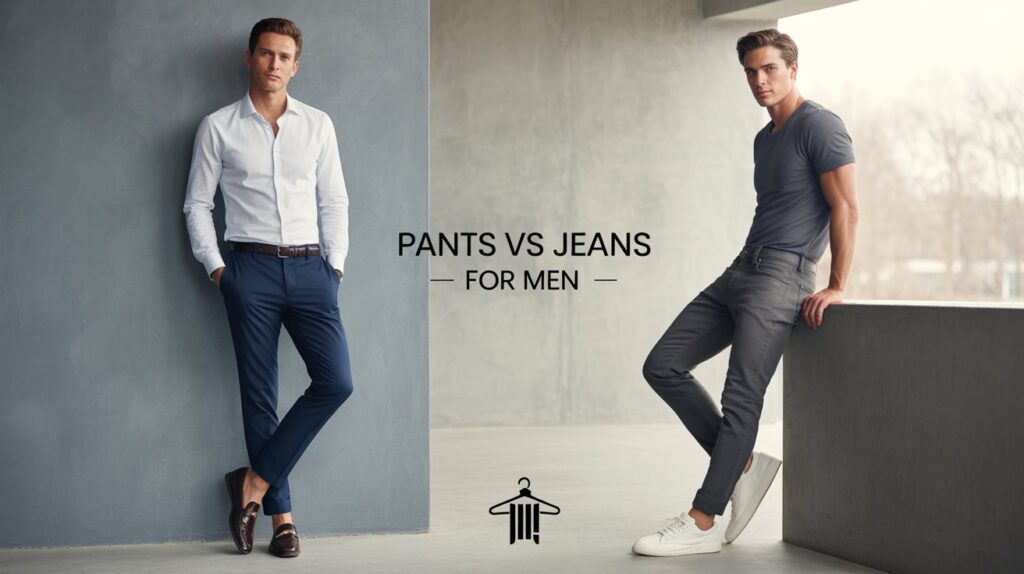
1. Introduction
When it comes to building a versatile wardrobe, the debate of pants vs. jeans for men is one of the most common style questions. In the US, both play an essential role—pants offer sophistication and polish, while jeans provide rugged comfort and casual appeal. Knowing when and how to wear each can make all the difference in looking sharp, staying comfortable, and dressing appropriately for any occasion. This guide breaks down the key differences, from style and fit to price and trends, helping men choose the right option for every situation.
Table of Contents
2. Pants vs. Jeans: Understanding the Basics
When it comes to men’s fashion in the US, the debate of pants vs. jeans for men often starts with understanding what each term really means. While the words “pants” and “jeans” are sometimes used interchangeably, they actually refer to very different categories of clothing in American fashion.
Pants in the US typically refer to all types of legwear that aren’t denim. This includes dress pants, chinos, khakis, joggers, and trousers. Pants are designed in a wide range of fabrics such as cotton, wool, polyester blends, and even performance materials. They’re usually associated with more formal or semi-formal settings, like the office, business meetings, or events where a polished look is important.
Jeans, on the other hand, are a very specific type of pants made from denim fabric. In American culture, jeans have become a symbol of casual wear and everyday comfort. Originating as durable workwear, jeans have evolved into a style staple for men of all ages. Whether it’s slim fit, straight leg, or relaxed cut, jeans are versatile but are most often worn in casual and smart-casual settings.
The main difference comes down to purpose and perception. Pants cover a broader style spectrum—from formal business attire to laid-back chinos—while jeans are generally tied to casual, rugged, and timeless looks. For US men, knowing the difference is important because it guides wardrobe choices: pants elevate your style for professional or formal situations, whereas jeans keep you comfortable and effortlessly stylish in everyday life.
In short, the basics of pants vs. jeans for men lie in fabric, function, and formality. Pants give you flexibility across occasions, while jeans provide durability and a casual American classic that never goes out of style.
3. Style Comparison: Pants vs. Jeans for Men
When deciding between pants vs. jeans for men, style plays a huge role in shaping the right choice. Both options are staples in American wardrobes, but they project very different looks depending on the occasion.
Pants Styles in the US
Pants cover a wide style range, giving men flexibility for both professional and casual settings. Dress pants and wool trousers create a sharp, polished image, perfect for offices, business events, or formal gatherings. Chinos and khakis, which are lighter and more relaxed, are favorites for semi-formal and smart-casual looks. They pair well with button-down shirts, polos, or even blazers, making them a versatile choice when men want to look refined without being overdressed.
Jeans Styles in the US
Jeans, on the other hand, are built around casual style. American men often choose between slim fit, straight leg, or relaxed cuts, depending on body type and comfort. Slim and straight-leg jeans are popular for modern, clean looks, while relaxed and bootcut styles appeal to those who prefer a more traditional or rugged vibe. Jeans also come in different washes—light, medium, dark, and distressed—each adding a unique personality. A pair of dark-wash jeans, for example, can be dressed up with a blazer, while faded denim pairs well with T-shirts and sneakers for a weekend look.
Style Differences at a Glance
- Pants lean toward sophistication and variety—ideal for professional, semi-formal, and fashion-forward outfits.
- Jeans emphasize casual comfort and timeless ruggedness—ideal for daily wear, casual outings, and streetwear-inspired looks.
In short, when it comes to style comparison of pants vs. jeans for men, pants give you a wider range of polished and professional options, while jeans remain the go-to for laid-back, all-American casual fashion. Both are essential, but choosing the right style depends on whether you want to look sharp or keep things relaxed.
4. Comfort and Fit: Everyday Wear in the US
When comparing pants vs. jeans for men, comfort and fit often become the deciding factors. In the US, where daily routines range from office jobs to casual weekends, men need clothing that adapts to different lifestyles.
Jeans and Everyday Comfort
Jeans are a long-standing favorite in American fashion because of their durability and comfort. Made from denim, they offer structure and flexibility that works well for casual wear. Many US men prefer jeans for running errands, socializing, or weekend outings because they feel sturdy yet stylish. Modern jeans also come with stretch denim blends, making them easier to move in compared to the rigid denim of past decades. Slim and straight fits are comfortable for most body types, while relaxed or athletic cuts provide more room for men who prefer extra mobility.
Pants and All-Day Wear
Pants, however, cover a broader range of comfort levels. Dress pants may feel less casual but are lightweight and breathable, especially those made from wool or cotton blends, making them suitable for long hours at work. Chinos and khakis are extremely popular in the US because they balance comfort with style—soft fabric, good breathability, and enough stretch to handle daily movement. Jogger pants, a modern style choice, take comfort even further and are often worn for travel or casual settings.
Climate and Lifestyle Considerations in the US
Climate also influences comfort. In colder states, jeans provide warmth and durability, making them a go-to option in fall and winter. In warmer regions, lightweight pants like chinos or linen trousers are more breathable, helping men stay comfortable in high heat and humidity.
Fit Matters Most
Ultimately, the right fit determines comfort. Poorly fitted jeans can feel restrictive, just as overly tight dress pants can be uncomfortable at work. That’s why many US men invest in multiple fits—slim or tailored pants for professional settings, and flexible jeans for casual wear.
In summary, when evaluating comfort and fit in pants vs. jeans for men, jeans excel in casual durability and versatility, while pants provide breathable, polished comfort that works best in professional or semi-formal settings. Both are essential for everyday wear in the US, but the choice comes down to lifestyle and climate.
5. Occasions: When to Wear Pants vs. Jeans in the US
One of the key factors in the pants vs. jeans for men debate is knowing when each option is appropriate. In the US, dress codes can shift depending on the occasion, and choosing the right bottom wear often makes the difference between looking polished and looking underdressed.
Work and Business Settings
For most professional environments, pants are the clear winner. Dress pants, chinos, or tailored trousers project a refined look that fits American office culture. Many US companies also follow a business-casual dress code, where chinos or khakis are acceptable alternatives to formal slacks. Jeans, while comfortable, are often too casual for business settings—though some workplaces allow dark, non-distressed jeans on “Casual Fridays.”
Casual Outings
Jeans are the go-to choice for casual wear in the US. Whether it’s grabbing coffee, attending a sporting event, or hanging out with friends, jeans offer a relaxed, versatile style. Distressed denim, relaxed fits, and lighter washes are especially popular for everyday outings. Pants, like chinos or joggers, can also work in casual settings, but jeans remain the all-American favorite for laid-back occasions.
Special Occasions
Events such as weddings, graduations, or dinner parties usually call for pants. Dress pants paired with a blazer or button-down shirt create a polished appearance. However, in less formal gatherings—like casual family events or informal dinners—dark-wash jeans can work, especially when styled with a crisp shirt or sports jacket.
Travel and Everyday Errands
Both pants and jeans are common for travel, but the choice depends on comfort. Many US men prefer chinos or joggers when flying or driving long distances because they’re lightweight and flexible. Jeans, while durable, can sometimes feel restrictive during extended travel, but remain a dependable choice for everyday errands.
Cultural Context in the US
It’s worth noting that American fashion leans heavily toward casual wear. Jeans symbolize everyday ruggedness and simplicity, while pants are linked to professionalism and formality. This cultural divide helps men decide: jeans for comfort and casual confidence, pants for style and sophistication.
In summary, when comparing pants vs. jeans for men, pants dominate formal and professional occasions in the US, while jeans lead in casual, social, and everyday settings. Owning both ensures men can dress appropriately for any situation without sacrificing comfort or style.

6. Durability and Maintenance
When comparing pants vs. jeans for men, another important factor to consider is durability and how easy each option is to maintain. In the US, where men often balance work, casual outings, and active lifestyles, the lifespan and care of clothing directly affect wardrobe choices.
Durability of Jeans
Jeans are well known for their toughness. Originally designed as workwear in America, denim became popular because it could withstand heavy use. Today, jeans remain one of the most durable clothing items men own. High-quality denim can last for years, even with frequent wear, and often looks better as it ages. The fabric resists tears and abrasions, making jeans a reliable option for casual and outdoor activities.
Durability of Pants
Pants, on the other hand, vary in durability depending on the fabric. Dress pants made from wool or polyester blends can hold up well in professional settings, but they are less resistant to rough use compared to denim. Chinos and khakis are sturdier than dress pants, but they still wear out faster than jeans if worn daily. For men in the US, pants are often seen as style-driven pieces rather than long-term rugged wear.
Maintenance of Jeans
Jeans are relatively low-maintenance. They don’t need to be washed as frequently as pants, since denim naturally masks dirt and maintains its shape over multiple wears. A simple cold wash and air drying usually keep jeans in good condition. Many American men find this convenience appealing, especially for everyday wear.
Maintenance of Pants
Pants, however, often require more care. Dress pants may need dry cleaning to maintain their sharp look, while chinos and khakis require regular washing and ironing to stay neat. Light-colored pants in particular can show stains more easily, adding to the maintenance effort. This makes pants less convenient for men who prefer low-effort wardrobe pieces.
Final Comparison
In the pants vs. jeans for men debate, jeans clearly stand out for their rugged durability and easy maintenance, making them a favorite for casual and long-term wear in the US. Pants, while less durable and higher maintenance, provide the refined look that jeans cannot match—making them essential for professional and formal occasions.
7. Price Comparison in the US
When it comes to pants vs. jeans for men, price is often a deciding factor. In the US, both options are widely available at different price points, ranging from budget-friendly essentials to premium designer labels. Understanding the cost differences can help men build a wardrobe that fits both their style and budget.
Price of Jeans in the US
Jeans are generally considered affordable and long-lasting. Well-known American brands like Levi’s, Wrangler, and Lee typically sell jeans in the range of $40 to $80. Mid-range fashion retailers such as American Eagle or Gap offer jeans around $50 to $100, often with seasonal discounts. On the higher end, premium labels like Diesel, 7 For All Mankind, or True Religion can cost anywhere from $150 to $300 per pair. Designer jeans from luxury brands like Gucci or Balmain may even exceed $500, though these are more about status and exclusivity than everyday wear.
Price of Pants in the US
Pants vary more widely in price because they cover multiple categories—dress pants, chinos, khakis, joggers, and trousers. Basic chinos or khakis from brands like Dockers, Old Navy, or Uniqlo usually fall in the $30 to $70 range. Mid-range retailers such as Banana Republic or Express typically sell tailored pants between $70 and $120. High-quality dress pants made of wool or premium fabrics from brands like Brooks Brothers or Hugo Boss can range from $150 to $300, while luxury designer pants from Armani or Tom Ford can cost $500 or more.
Value for Money
From a cost perspective, jeans often provide better long-term value because of their durability and low maintenance. A single pair of jeans can last several years, even with frequent wear. Pants, especially dress pants, may require more frequent replacement or dry cleaning, which adds to overall costs. However, pants offer greater versatility in professional and formal settings, which justifies their higher price for men who work in business or corporate environments.
Final Takeaway
In the pants vs. jeans for men price comparison, jeans are typically the more cost-effective option for casual and everyday wear in the US, while pants are an investment in style, professionalism, and versatility. Most American men benefit from owning both—affordable jeans for daily comfort and a few pairs of quality pants for work and special occasions.
8. Fashion Trends in the US
The conversation around pants vs. jeans for men is also shaped by changing fashion trends in the US. While both remain wardrobe essentials, styles evolve as American culture, workplaces, and lifestyle preferences shift.
Jeans Trends in the US
Jeans continue to dominate as a timeless fashion piece, but trends in fit and style change every few years. In 2025, straight-leg and relaxed-fit jeans are making a strong comeback, replacing the ultra-skinny silhouettes that were popular in the 2010s. Dark-wash and clean-finish denim are in demand because they can transition easily from casual outings to smart-casual events. At the same time, distressed and vintage-inspired denim remain popular among younger men influenced by streetwear culture. Sustainability is also shaping denim fashion, with many US men now choosing eco-friendly brands that use recycled fabrics or water-saving production methods.
Pants Trends in the US
Pants are seeing growing popularity, especially in work and semi-formal settings. Chinos and slim-fit trousers are staples for business-casual offices, reflecting the modern American workplace that blends professionalism with comfort. Neutral tones like beige, gray, and navy remain safe choices, while earthy shades and soft pastels are becoming trendier for men who want a contemporary look. Athleisure continues to influence pant styles too, with joggers and tech-fabric pants becoming acceptable beyond the gym—often worn for travel or casual Fridays.
Cultural Influences on Trends
US fashion is heavily influenced by celebrity culture, tech professionals, and streetwear. For example, Silicon Valley’s relaxed dress codes have made chinos and casual pants more acceptable in professional spaces, while hip-hop and sports culture have kept jeans and joggers in high demand. Social media also drives micro-trends, with many younger men experimenting with oversized fits, cropped trousers, and vintage denim looks.
The Balance of Trends
Overall, the pants vs. jeans for men trend in the US is about balance. Jeans remain the go-to for casual and timeless fashion, while pants are becoming more versatile, bridging the gap between professional style and everyday comfort. For American men, following these trends often means owning a mix of both, ensuring they can adapt to any setting while staying on-trend.
9. Pros and Cons: Pants vs. Jeans for Men
When comparing pants vs. jeans for men, it helps to weigh the pros and cons of each. Both are wardrobe essentials in the US, but they serve different purposes and come with unique advantages and drawbacks.
Pros of Pants
- Versatility in Style – Pants cover a wide range, from dress pants to chinos, making them suitable for formal, semi-formal, and business-casual occasions.
- Professional Appearance – In American workplaces, pants are often required for office wear, interviews, and special events.
- Lightweight Options – Many pants are made from breathable fabrics like cotton, linen, or blends, ideal for warmer US climates.
- Variety of Colors and Fits – Pants are available in multiple shades and cuts, allowing men to experiment with their style beyond basic denim.
Cons of Pants
- Less Durable – Dress pants and chinos wear out faster than denim, especially with daily use.
- High Maintenance – Many pants require ironing or even dry cleaning, adding to the cost and effort.
- Limited Casual Appeal – While chinos and joggers work casually, most pants don’t offer the rugged, laid-back vibe of jeans.
Pros of Jeans
- Durability – Denim is one of the toughest fabrics, making jeans a long-lasting investment.
- Low Maintenance – Jeans don’t need frequent washing and generally require less care than pants.
- Timeless Style – Jeans are a staple of American casual fashion, suitable for nearly any relaxed setting.
- Variety of Fits and Washes – From slim and straight to relaxed and bootcut, jeans offer plenty of style choices for US men.
Cons of Jeans
- Limited Formal Use – Even dark-wash jeans may not be acceptable in strictly professional or formal environments.
- Less Breathable – Denim can feel heavy, especially in hot or humid states, making them less comfortable year-round.
- Fit Challenges – Finding the perfect fit can be difficult since jeans can feel restrictive if too tight or baggy if too loose.
Final Takeaway
In the pants vs. jeans for men comparison, pants excel in professionalism, style variety, and warm-weather comfort, while jeans win in durability, low maintenance, and casual versatility. For US men, the best approach is to keep both in the wardrobe—pants for work and formal occasions, jeans for everyday comfort and timeless style.

10. How to Choose Between Pants and Jeans (Decision Guide for US Men)
Deciding between pants vs. jeans for men often comes down to lifestyle, setting, and personal style. In the US, where dress codes vary widely—from laid-back workplaces to formal events—choosing the right option ensures you look appropriate while staying comfortable. Here’s a practical guide to help men make the right decision.
1. Consider the Occasion
- Work or Formal Events – Pants are the better choice. Dress pants and chinos project professionalism, making them essential for business meetings, job interviews, or weddings.
- Casual Outings – Jeans dominate here. They’re perfect for errands, hanging out with friends, or attending casual events where comfort matters most.
2. Think About Climate
- Warmer States (like Florida or Texas) – Lightweight pants such as chinos or linen trousers are more breathable, helping you stay cool.
- Colder States (like New York or Michigan) – Jeans offer warmth and durability, making them ideal for fall and winter wear.
3. Factor in Comfort and Fit
- If you value flexibility and ease of movement, opt for chinos or joggers.
- If you prefer rugged durability with a casual edge, jeans—especially stretch denim—are a dependable option.
4. Match Your Personal Style
- Classic and Professional – Choose tailored pants in neutral colors like navy, gray, or black.
- Casual and Rugged – Go for jeans in straight or relaxed fits with a medium or dark wash.
- Trendy and Modern – Mix it up with slim-fit chinos or stylish denim in unique washes.
5. Budget and Maintenance
- Jeans are cost-effective since they last longer and require less care.
- Pants may need more upkeep, but they elevate your look when professionalism matters.
Final Decision
In the pants vs. jeans for men debate, the best choice depends on balancing lifestyle and wardrobe needs. Most US men benefit from owning both: a few pairs of reliable jeans for casual wear and several versatile pants for work and formal occasions. This combination ensures you’re always prepared, whether it’s for the office, a night out, or a relaxed weekend.
11. Conclusion
The debate of pants vs. jeans for men comes down to lifestyle, occasion, and personal style. In the US, both options are essential because they serve different purposes. Pants bring sophistication, professionalism, and variety, making them the go-to choice for work, formal events, and settings where polished style matters. Jeans, on the other hand, represent comfort, durability, and timeless casual appeal, making them a staple for everyday wear.
Instead of viewing pants and jeans as competitors, think of them as complements. A well-rounded wardrobe in the US includes both—jeans for weekends, casual outings, and relaxed settings, and pants for offices, special occasions, and when you want to look sharp.
In short, the key is balance. By investing in versatile pants and reliable jeans, men can confidently dress for any occasion while staying comfortable and stylish.
12.FAQs
What is the main difference between pants and jeans for men in the US?
The main difference is in fabric and purpose. Pants are made from materials like cotton, wool, or blends and are suitable for formal, semi-formal, and business-casual settings. Jeans, on the other hand, are made of denim and are mostly worn for casual and smart-casual occasions in the US.
Are jeans acceptable in professional or business settings in the US?
In most US workplaces, jeans are considered too casual for daily office wear. However, some companies allow dark, non-distressed jeans on casual Fridays. For interviews, meetings, or formal events, pants such as chinos, slacks, or dress trousers are the safer choice.
Which lasts longer: pants or jeans?
In the pants vs. jeans for men comparison, jeans usually last longer because denim is a stronger, more durable fabric. Pants, especially dress pants, can wear out faster and may need extra care like dry cleaning or ironing.
What should men in the US consider when choosing between pants and jeans?
Men should consider the occasion, climate, and personal comfort. Pants are best for offices, weddings, and formal gatherings, while jeans are ideal for casual outings and everyday wear. Climate also matters—lightweight pants suit warmer states, while jeans work better in colder regions.
Are pants more expensive than jeans in the US?
Generally, yes. Basic jeans from US brands like Levi’s or Wrangler are affordable and long-lasting. Pants, especially tailored or wool dress pants, often cost more and require higher maintenance. That said, both pants and jeans are available across all price ranges, from budget-friendly to luxury.
